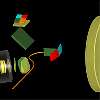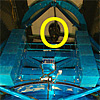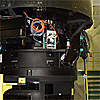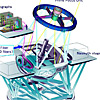Topics
Next-Generation Instrument FMOS Joins Subaru
April 8, 2009
The mission of the Subaru Telescope is to explore the universe further and comprehend nature more deeply. With an 8.2-meter (27 ft) mirror and a wide array of sophisticated instruments, astronomers at Subaru explore nearby stars looking for planetary systems as well as study the farthest known regions of our universe. Recently, a significant step towards these goals was made with the “first-light” inauguration of a new ultra-modern instrument.
There are eight innovative cameras and spectrographs at Subaru optimized for various astronomical investigations in optical to mid-infrared wavelengths. On the night of 14 May 2008, a second-generation instrument was introduced to the night sky, FMOS (fiber Multi-Object Spectrograph). FMOS is the most powerful wide-field spectroscopy system available on any telescope and is the only instrument that enables near-infrared spectroscopy of over 100 objects.
Background
Spectroscopy is the study of the interaction between electromagnetic radiation (light) and matter, where the spectrograph measures the spectra emitted by target objects. It is used in astronomy to measure chemical abundance, and distinguish the physical properties (e.g. mass, density, temperature) of astronomical objects, such as stars and galaxies. Spectroscopy studies may also determine the redshift (z) of galaxies, and assess the strength of star-forming activity. The new FMOS system measures the spectra of multiple target objects to obtain a unique chemical “fingerprint” and concentration.
Design Details
FMOS is the culmination of a Japan-UK-Australian collaboration to design and build a spectrograph system for Subaru. Contributing to the success of FMOS are scientists, engineers, and staffers from Subaru, Kyoto University, Tohoku University, University of Oxford, Rutherford Appleton Laboratory (RAL), University of Durham, and the Anglo-Australian Observatory.
FMOS consists of three main subsystems: the prime focus unit, a fiber bundle unit, and two spectrographs. The prime focus unit for infrared (PIR) is approximately 8 feet (2.5 m) tall, weighs over 5,700 lbs (2,600 kg), and is mounted atop Subaru to take images at the prime focus position with a 30-arcminute field of view (FOV). The mechanical components of PIR consist of: 1) the attachment mechanism to the telescope; 2) a wide-field corrector lens system with its housing; 3) an optical fiber positioning system (called Echidna), which aligns 400 optical fibers); 4) a focal plane imager CCD system to measure the position of each 100-micron diameter fiber; and 5) a Shack-Hartmann sensor for checking the shape of the primary mirror. Using Subaru’s robotic instrument exchange system, this massive PIR unit can be installed with a positional accuracy of less than 500 microns (<0.02 in).
The highlight of PIR is the Echidna system enclosed within. Echidna is the “heart” of FMOS because of its innovation, and because it is the lead instrument component in fiber spectroscopy. The Echidna-type fiber positioner is a unique design using piezo-driven stick-and-slip motion versus the traditional fiber-button type positioner. The specialty of the system is that it houses 400 independently moving fibers within Subaru’s wide field of view. Echidna has a typical fiber positional accuracy of 5 microns (~0.0002 in).
Fiber cables for FMOS are utilized to feed light from PIR to the spectrographs. The 400 fibers of the Echidna array feed into two fixed main cables measuring 1-1/3 inches across (33 mm), which then snake 200 feet (60 m) down the telescope and through the enclosure to the two spectrographs. The optical fibers are sealed inside plastic tubes spiral wrapped around a central strength member so that any tension on the cables goes to the strength member and not the fibers. A unique aspect to the fiber connector system is that the focal ratio of F/2 received by Echidna must be converted to F/5 for the spectrographs. This conversion is achieved in the fiber connector couplings at the PIR.
The light observed at the PIR and guided/transmitted through the fiber bundles is ultimately received by two spectrographs (IRS1 & 2) that view 400 objects (200x2) simultaneously in the near-infrared part of the spectrum between 0.9 and 1.8 microns (visible light is between 0.4 and 0.8 microns). Due to their significant size (17x8x7 ft), a new observing platform was constructed inside the Subaru building to house these systems. Within the spectrograph, the light output beam from the fiber slit reflects several times off a 4.6-foot (1.4 m) mirror, passes through two corrector lenses (Schmidt plates), an anti-dispersive element (reverse VPH grating), before it inputs a camera. The spectral resolution (the ability to separate closely spaced spectral features) is 2200 in high dispersion mode and 500 in low dispersion mode.

The light path of
the spectrographs
(animation) Note 1
Astronomers can collect high-resolution or low-resolution spectra but not both. A design challenge for both spectrographs was how to mask bright hydroxyl (OH) emission lines that are seen as an unwanted noise source in the sky background. These hydroxyl airglow lines are suppressed by using blacked strips on the mask mirror in the pre-optics systems (a kind of spectroscopic filter). A step-by-step animation shows the light path of the spectrographs.
Another unique design feature of the spectrographs is refrigeration. To minimize thermal background radiation or “noise” negatively affecting instrument readings, both spectrograph systems are mounted into pressurize insulated boxes and continuously cooled to approximately -60 °C.
FMOS Science
The FMOS system studies the near-infrared wavelength because as distant galaxies move away faster in our expanding universe, their visible wavelengths are being observed from earth in a longer wavelength (this effect is called "redshift"). Due to this redshift effect, the visible light from distant galaxies in the early universe is “shifted” to a longer wavelength and observed in the near-infrared. Studies in the near-infrared are done at Subaru because the wavelengths are very close to that of visible light, behave in a very similar manner, and can be detected using a mirror and similar electronic devices, such as cameras and spectrographs. Astronomers using FMOS would explore various scientific frontiers from nearby substellar objects (e.g. brown dwarf) to the large-scale structure of the universe at distances with redshift greater than 1. The scientific output by FMOS will be significant, resulting from not only the instrument’s spectroscopic capabilities, but also its “multiplicity” (multiple target capacity) and wide field of view all working together with the large light-gathering power of Subaru.
Since "First Light" in May 2008, engineering observations have been futher characterized the instrument and prepared it for science operations. Dr. Naoyuki Tamura, Principal FMOS scientist at Subaru, reported “first light was a big milestone for us. So far, we have been observing bright stars to improve fiber positional accuracy and better understand the other characteristics of the instrument, and we are now in a position to try longer exposures for fainter objects with auto-guiding”. He concluded, “we look forward to more success with FMOS and hope to have it available for open use in 2010”.
For detailed technical specifics about FMOS, extensive informational reports can be found in journals and conference proceedings from the International Society of Optical Engineering – SPIE (see article). Details concerning other instrument systems and innovative technologies operating at Subaru may be found within our website.
Note 1: The words that show up in the animation explain the light path of each observation mode. The modes are explained below.
- Low Resolution: Instrument setup is in low resolution mode.
- J-short: High resolution mode focusing the shorter side in J band.
- J-long: High resolution mode focusing the longer side in J band.
- H-short: High resolution mode focusing the shorter side in H band.
- H-long: High resolution mode focusing the longer side in H band.




